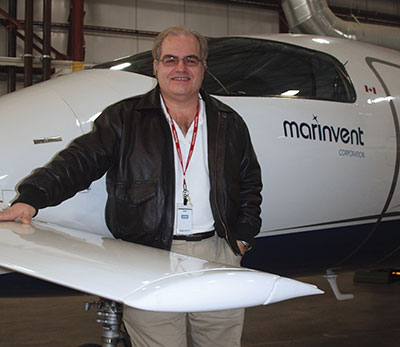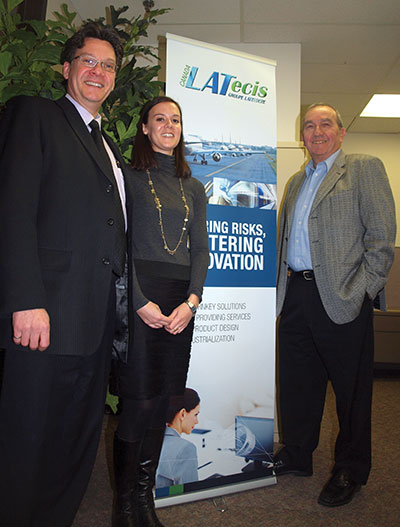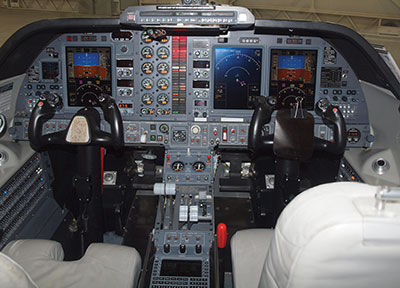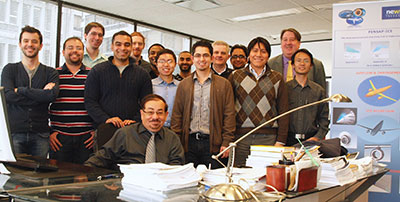
Features
The difference makers
In terms of its influence on Canadian aerospace, it’s difficult to match the power of the Montreal aerospace cluster.
July 9, 2013 By Stacy Bradshaw
In terms of its influence on Canadian aerospace, it’s difficult to match the power of the Montreal aerospace cluster.
 |
| Marinvent president/CEO John Maris shows off his company’s impressive Piaggio Avanti 180. (Photo: Matt Nicholls)
|
With more than 215 companies and annual sales revenue of more than $12.1 billion, it’s the nation’s aerospace jewel. Just how influential is it? On a global scale, Montreal’s cluster is the world’s third largest aerospace cluster after those in Toulouse, France and Seattle and ranks sixth in the world in annual sales.
Some of the country’s most influential firms call Montreal home, with national and international powerhouses such as Bombardier Aerospace, Pratt & Whitney Canada, CAE, Héroux-Devtek, and Bell Helicopter all making their mark. And while it’s easy to recognize the exploits and international influence of Montreal’s major tier one aerospace leaders, there are countless other companies in this cluster that are making their marks both here and abroad. Wings sat down with the leaders of three dynamic firms to get a look at how their aerospace achievements are shaping the industry, and how smaller firms are positioning themselves with their larger brethren.
 |
|
| The team at LATECOERE Services Canada. From left: Eric Giguère, general manager; Delphine Ramade, business development manager; Charles Dieudé, vice-president. (Photo: Matt Nicholls) |
Forging out in a new market: LATECOERE Services Canada
You know you qualify as a small Canadian aerospace firm when the dry wall guy is one of your “go to” stops on your telephone speed dial.
This is certainly the case for the small but expanding engineering design services firm LATECOERE Services Canada, a Canadian subsidiary of the European aerospace giant, the Latecoere Group. Moving the walls of its tiny Laval office has become a priority as more and more employees join the fold and the firm expands its growing Canadian footprint.
Founded in 1917 by famed French aviator and aerospace legend Pierre-Georges Latécoère, the Latecoere Group is a tier one partner to some of the world’s top OEMs. With more than US$843 million in revenues in 2012 – and a U.S. order book of more than $2.8 billion – the Latecoere Group has 4,288 employees in 11 countries and has firmly established itself as a global leader in aerospace development.
The group is divided into three main businesses:
- Latecoere, which specializes in the development of aerostructures such as fuselages and doors for a variety of key clients including Airbus, Boeing, Dassault Aviation, Embraer and Bombardier.
- LATelec, which has extensive experience in the development of electrical racks and harnesses for both commercial and space clients including Eurocopter, Airbus, EADS Astrium and Dassault Aviation.
- LATecis offers structural design engineering services. The company provides turnkey solutions that span from design delivery of production tooling, automated lines and specialized equipment.
Latecoere is the No. 1 producer of aircraft doors worldwide and is the sixth ranking producer of aircraft fuselages in Europe. LATelec is the leading producer of electrical racks in the world and is second in the development of electrical harnesses. Its design and engineering group LATecis is well respected for its thorough designs, and for efficiently bringing all developmental projects together in one clean package.
With its successful European footprint well established, LATECOERE Services Canada was born in November 2010 when the fledgling startup was awarded its first major contract – the design project for the forward fuselage section of Bombardier’s CSeries aircraft. LATECOERE Services Canada had a concrete physical presence less than 18 months later, when the tiny Laval office was established to continue the Latecoere tradition here in Canada. Canada represents the 10th country where the Latecoere Group is present worldwide.
“It was always the company strategy to come and establish themselves in Canada,” says Éric Giguère, general manager of LATECOERE Services Canada, a former longtime engineer with Bombardier. “We ended 2011 with two employees. In March 2012, we won a contract that consisted of building a tool to install the main landing gear on the CSeries. That was our first tool project in North America.
“But the most important thing for LATECOERE Services Canada was to become independent in the sense of having a full capacity offering as we have in France. We’re not a front office to try to get contracts. Our goal is to create the business here in Canada.”
Creating business and establishing a firm Canadian footprint is precisely what LATECOERE Services Canada is doing. In addition to the major contracts from Bombardier, LATECOERE Services Canada has a diversified product offering of engineering design services, turnkey tooling systems for manufacturing and assembly lines which allows for the design of product and tooling simultaneously. It also has considerable expertise in onboard wiring – the design of wiring systems, electrical racks and harnesses.
The drywall guy has indeed been busy. When Wings visited in the spring, Giguère pointed out where the wall of the office had ended and where it was moving to . . . quite a few feet farther down the line. The office was alive with activity, as employee count has gone from two in 2011 to 45 by the end of this year, some 60 next. The majority of the LATECOERE Services Canada team consists of designers, stress engineers and electrical engineers, with the talent pool drawn from across the globe. Finding just the right engineers and design team members at the cutting edge of aerospace design, is extremely difficult, notes Giguère.
“When we started, some people came to us saying there is a lack of skilled people. We are doing business with our customers – so we won’t get people from them. We went around the world looking for talent. Some 95 per cent are coming from outside Canada. And yes, we are helping them adapt to the snow. I think those from India have the greatest learning curve.”
In addition the landing gear tool on the CSeries, design and stress teams are working on the new local business jet program development. Giguère is also keen to expand the firm’s commercial business and sees the military market as definite growth potential.
“When you look at the growth we have had, we are doing very well,” he says. “We are happy with what we have accomplished. And I think what has happened in Canada with the new programs and the companies that are coming in, it’s a very positive environment.”
Sounds like the drywall guy will be plenty busy at the Laval office of LATECOERE Services Canada in the months and years ahead.
 |
|
| Marinvent’s state-of-the-art Piaggio Avanti 180 boasts a cockpit that comes complete with a number of multimillion-dollar enhancements. (Photo: Marinvent Corporation)
|
Reducing the risks: Marinvent Corporation
When the president of the United States wants to get in touch with you for a pressing matter, you know that you’ve “arrived” as an entity of influence – even if the “president” in this case is a make-believe one.
That’s the situation Marinvent Corporation’s John Maris found himself in in mid-March when Wings caught up with the enigmatic president/CEO of this small but dynamic Montreal-based aerospace firm. Maris had just arrived at Mid Canada Mod Centre in Mississauga in the company’s technologically advanced Avanti Piaggio 180 for maintenance and enhancements following meetings with NASA in the U.S.
“That was Martin Sheen’s production company on the phone,” John Maris says to me casually as we get ready for our interview. “He hosts his own show now on PBS called Breakthroughs (Sheen’s award-winning human interest show focusing on education). They evidently got one of our last press releases . . . would be fun to do that.”
The latest in a string of noteworthy press releases Maris is referring to details the company’s selection as the winner of the C2-MTL prize for Aviation & Aerospace for its adaptive fight test bed project. One of 10 such prizes awarded annually, the C2-MTL is given to a company in recognition of the highly creative projects that provide solutions to real commercial issues in various sectors.
Marinvent’s adaptive flight test bed project is a boon for the unmanned aviation category – a platform that is ideal for companies and regulators looking to develop, evaluate, test and certify Unmanned Aerial Systems (UAS) and integrate them into civil aerospace. Using its Piaggio Avanti P-180, Marinvent can re-architect the avionics and safety systems on the aircraft and integrate an on-board UAS ground station and satellite link that allows them to control and fly the aircraft as if it were unmanned, even though a safety pilot is on board at all times. As a result, Marinvent can quickly and efficiently fly novel avionics and UAS systems in civil airspace without the need to undertake expensive and time consuming aircraft modifications to do so.
It’s a process that Marinvent can do with virtually any flight deck platform – plug and play avionics testing. What’s more impressive, is that the $10-million Piaggio can replicate virtually any avionics architecture, making certification and flight-testing a snap.
The award is the latest in a bevy of accolades Marinvent has garnered in the past number of years for its groundbreaking technologies. Other noteworthy accolades include a Canadian American Business Achievement Award (2003), CASI Trans Canada (McKee) Trophy (2005), Ecole de Technologie Supérieure (ETS) Award of Excellence (2005), Aviation Week and Space Technology Laureate (2006), New Zealand’s Minister’s Award to Industry, CBAA Award of Merit (2006), and the AQA Prix de l’Enterprise 2006 as the Aerospace Association of Quebec’s Aerospace Company of the year.
A privately held corporation that Maris proudly says carries no debt, Marinvent – which aptly stands for “Maris inventions” – was founded in 1983 for the purpose of conducting research and aerospace development. The company boasts three key areas of specialization including human factors engineering, systems engineering and flight test and certification services. It also develops advanced navigational systems for several different types of aircraft and helped NASA with the development of the Synthetic Vision System, a key component of NextGen cockpits. Reducing risks, cutting life cycle costs/time to develop, and reducing time to certify novel aerospace technologies for fixed-wing, rotary-wing and unmanned platforms is the bread and butter behind what Marinvent does.
“It’s impossible to explain in detail, but what Marinvent does is a very simple concept,” Maris says. “We take the risk out of complex aerospace programs. How do we reduce risk? One, we have a team that’s been together for quite some time. Typically the average tenure with Marinvent is between 10 and 15 years in the same job, working with the same people. We don’t claim to be able to do anything that Bombardier or Boeing or whatever can’t do. Of course they can do anything that we can do. But can they do it practically and with our agility?”
The Marinvent team consists of a dozen capable and highly dedicated employees, including esteemed Canadian helicopter test pilot Shawn Coyle, and Mark Haynes, the company’s program manager in the U.S., who has more than 17 space shuttle flights as a NASA Mission Controller on his resumé. It’s an impressive array of talent. And in the course of our lively 75-minute interview, Maris points out Marinvent’s impressive client list, one few companies could achieve at all, let alone in such a short time frame or with such a small team. To wit, as Wings went to press, Marinvent had just secured its first Canadian deal – providing two courses on standardization training for Bombardier’s CSeries flight test personnel.
“I’m pointing this out to show you the sort of things we do and yet no one has ever heard of Marinvent,” he says, smiling. “For a long time, we didn’t even market ourselves. We do now, but essentially it was word of mouth.”
Maris is a high-energy kind of guy and you get the feeling he’s never at a loss for words. He sets the bar high when it comes to talent, and is clear about what his vision is for certain projects. An outspoken force in the Montreal aerospace community, he speaks at industry events and worked closely with other Canadian aerospace leaders in the development of aspects of the Emerson report. His resumé includes work as a test pilot in the Royal Canadian Air Force (CP 140 crew commander, project officer and engineering test pilot for the CC-130H Tactical Transport Tanker), International Space Station MCE manager with the Canadian Space Agency and more. He is also president/CEO of the Advanced Aerospace Solution in North Carolina and has a pair of masters degrees in aviation management and air science from Embry-Riddle Aeronautical University (he is working on a doctorate in aviation human factors.)
Maris and his firm achieved commercial success early on with the development of Jeppesen’s JeppView Electronic Charting program. Introduced in 1996, the program now has thousands of customers worldwide using about 40,000 charts updated every two weeks. The program is called TCL/MC3 and it has a special meaning, says Maris, especially for Trekkies.
“TCL stands for ‘The Captain’s Log’ and it’s a double pun; the first part of it refers to Star Trek, and of course thinking of the tablet computers, we can control our plane from an iPad mini just like James T. Kirk. The other half of the captain’s log is more significant. My dad was a sea captain and he’s the one that got me my start in life and in business and everything else. ‘The Captain’s Log’ was actually in deference to my Dad, ‘the Captain’ but with something that other people would understand. The MC3 charting integrity is guaranteed at the same level as the aircraft’s primary navigation systems, which is a unique accomplishment.”
Integrity, experience, energy, creativity, a commitment to reducing risk in aviation and so much more. These are the driving forces behind everything John Maris does and all are key elements of his growing, dynamic Montreal-based aerospace firm.
 |
| This team really is cool – the engineers at Newmerical Technologies Inc. who melt away the complexities of ice formation on aircraft and other structures. (Photo: Matt Nicholls)
|
Breaking it down: Newmerical Technologies Inc.
Even if you didn’t know in advance that Dr. Wagdi G. Habashi is a highly respected professor and leader of a small but very talented team at Newmerical Technologies International (NTI), you likely would guess he was indeed a professor or teacher upon first meeting him.
Thorough and meticulous in describing his company’s background in the utmost detail, Habashi has the quiet confidence, patience and communication skills to make the most complicated mathematical and software engineering concepts discernable. Taking complex data and breaking it down for multiple applications, melting away the complexity of a seemingly difficult scenario, is the crux of what NTI is all about.
NTI has become the world leader in the development of in-flight icing simulation software and associated design, testing and certification services – an “agile” company at the frontier of research in its field. It offers a one-stop shop for a structured and systematic methodology to in-flight icing certification of aircraft, rotorcraft and jet engines. With its patented 3-D Computational Fluid Dynamics (CFD) software technology, NTI focuses on niche areas of aerodynamics that are too complex to tackle such as in-flight de-icing, aerodynamic design and computational wind engineering.
And its services don’t stop there – if you’re tired of opening up your ice cream and finding it soft in one place and hard in another, these guys can help save the day. Dreyer’s took them up on the challenge and poof, no more non-uniformity – your next tub of Dreyer’s Ice Cream is good to go. The chiller’s operator does not even know that he is using a sophisticated aerospace application – but NTI can help.
If you are the Government of Canada adding buildings to Tunney’s Pasture, or the Cirque du Soleil adding floors to your headquarters, or the McGill University Health Center creating the hospital of the future, or the NYC developer of the immense Atlantic Yards, or constructing the new Marriott Hotel-cum-Condos around Phillips Square in Montreal, and you want to ensure that pedestrians will not be inconvenienced by wind effects when coming to your building, NTI can help, there, too.
“Globally, we are a small company of 18 engineers, most of them with Masters and PhDs,” says Habashi, who not only heads up NTI as president/CEO but is also an award-winning mechanical engineer and professor/director of McGill University’s CFD Lab among other key leadership roles. His cosy McGill office is brimming with academic and industrial awards, including four walls full of decorative “steins” – gifts to commemorate his many speaking engagements worldwide. It’s obvious this is a man in demand and passionate about what he does. No wonder, Quebec knighted him in 2012 as Chevalier de l’Ordre national du Québec.
“Yes, we are very, very dedicated, passionate people who are not just in it for the commercial success – we truly believe in what we are doing: we want to make flying into the clouds safer, through science. It’s an amazing atmosphere,” he says.
Amazing is an ideal way to describe the software and other tools NTI has created, which can, through 3-D simulation, track ice development on aircraft at various stages of flight, enabling major OEMs, pilots and governments to understand the process of ice formation and work to alter initial aircraft designs or make key modifications later in the developmental process, before seeking certification. And although the company does not have icing tunnels and does not have airplanes to fly – traditional tools to test and monitor the formation of ice on aircraft for certification or design – it does have associations with companies that do have these assets. NTI’s own creation, its special 3-D software, however, can easily shorten all of those traditional processes.
“It’s that which allows us to be, from the beginning, a one-stop shop for anyone who wants to certify an aircraft to safely fly in ice. And when I say an aircraft, I mean a rotary-wing aircraft or a fixed-wing aircraft,” Habashi says.
Habashi founded NTI in 2000, continuing his long and distinguished career in academia and, as well, as Aerodynamics Consultant to Pratt & Whitney Canada for 24 years.
The idea for the company was born after it was repeatedly brought to his attention that there was a glaring need for advanced icing tools and products among pilots complaining that available icing methodologies were woefully inadequate and did not duplicate reality.
NTI is currently majority owned by Habashi and his children and went private in 2011, after 10 years on the TSX-Venture listed as “CFD.” It has developed an impressive list of clients over the years in 16 countries. Firms such as Airbus, Bombardier Aerospace, Lockheed Martin, Bell Helicopter, Eurocopter, General Electric, Honeywell, to name a few in its three focal areas, have all used the company’s icing tools or engineering services.
It is a list that continues to grow, especially in countries such as China, Korea, Japan, Turkey, Poland where the budding aerospace industry, unimpeded by legacy approaches, has zeroed in on NTI’s technology as being the most modern solution.
The reasons for its success are simple: OEMS developing aircraft, engines or any other structural components are seeking safer, more cost-efficient components that are less susceptible to ice buildup – not to mention the enhanced cost savings, fuel consumption in flight and more advantage that stem from operating “clean” aircraft.
NTI has various competitors in its field including NASA in the U.S., ONERA (Office National d’Études et de Recherches Aérospatiales) in France, and CIRA (Centro Italiano Ricerca Aerospaziali), but despite providing their indigenous companies with free software, none boosts the amount of detail NTI’s 3-D software can provide. Current tools offered by the competition cannot duplicate NTI’s detailed 3-D ice prediction; ice protection equipment design; flight conditions evaluation; engine available heat at different power settings; performance of the anti-icing protection system and more. It’s a package that is setting NTI apart from its competitors.
And after watching a comprehensive video of the technology prepared by NTI’s enthusiastic engineering team when I visited the company headquarters in downtown Montreal, the best thing that can be said is that the buildup behind “the goods” is more than legit.
“It’s a very, very slow-moving process to get new products accepted in this field,” says Habashi. “They are quite conservative about accepting new technologies. So, what we do is a creeping slow but structured and systematic application of science to the certification of aircraft, rotorcraft and jet engines so that they are certified in the shortest time and with the maximum safety possible. . . ours is a very realistic tool that uses very complex mathematical calculations to predict the shape of ice – its depth, shape, volume. We do all of this analytically, even before the airplane is designed: “an ounce of prevention is worth a pound of cure!”
NTI’s biggest success? Well, what company in the world has yet managed to get the FAA, EASA and Transport Canada to grant three Supplemental Type Certifications based on analytical ice shape prediction and only flight-testing, “without ever resorting to an icing tunnel”? NTI has, marking a major milestone towards virtual certification.
An analytical, calculated approach to solving a complex problem that touches so many levels of the aerospace industry is the best way to describe Habashi and his dedicated team of young engineers, a small company finding its niche, creating a cache of state-of-the-art tools and building a name for itself on the global stage. It’s also the best way to describe Montreal’s aerospace brethren, large and small – countless professionals helping Canada solidify its position as a world leader in aerospace.
| Making their mark We all know about Montreal aerospace stalwarts Bombardier Aerospace, CAE, Bell Helicopter and Héroux Devtek, but what of some of the medium-sized to smaller firms establishing themselves on the global stage? Here are some companies making noise in their own right. ABB: Located in Quebec City, ABB is considered a key influencer on the province’s aerospace scene. ABB specializes in the development of analytical spectrometres and infrared sensors for industrial processes. The firm is a key player in the defence and space markets. ADACEL: This 140-employee firm designs simulation and software for the aerospace, maritime and defence markets. Some of its most sought-after products include air traffic control software solutions used for the training of air traffic controllers and products for air traffic management. ALTITUDE AEROSPACE: Altitude is a leading engineering design firm that works closely with major OEMS in the development of key structural sub assemblies such as aircraft fuselage sections, wing boxes doors and cockpit structures. The company also prides itself on its R&D investments. CIARA: New to the aerospace industry – but big players in the European automotive industry – Ciara is a global provider of products, technologies and software solutions. One of its key products is business management software that works to boost other companies’ productivity. SONACA: This Montreal affiliate, which is headquartered in Belgium, this Montreal affiliate specializes in the development of large aerospace structures. Key partners include business and regional commercial aircraft OEMs, including Bombardier, Embraer, Mitsubishi, Spirit Aerosystems and Héroux-Devtek. MDA: An intelligence leader in communication technology and surveillance, MDA is best known as its formal incarnation Spar, the leaders in the development of the Canadarm. Today, MDA is actively generating Next Gen technologies in a variety of robotics, communications and satellite-based technologies that benefit both the aviation and space markets. |